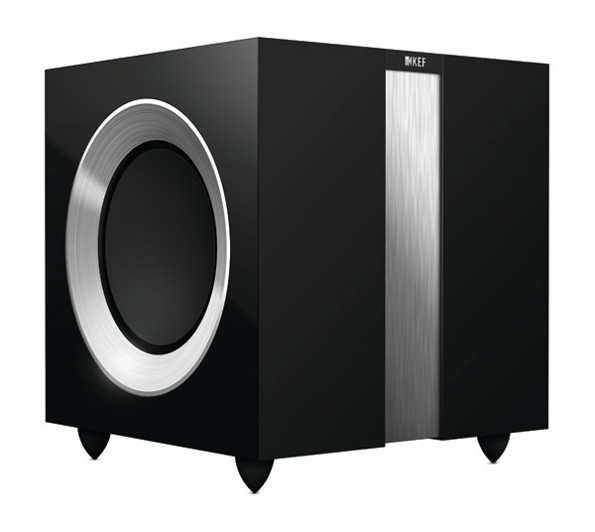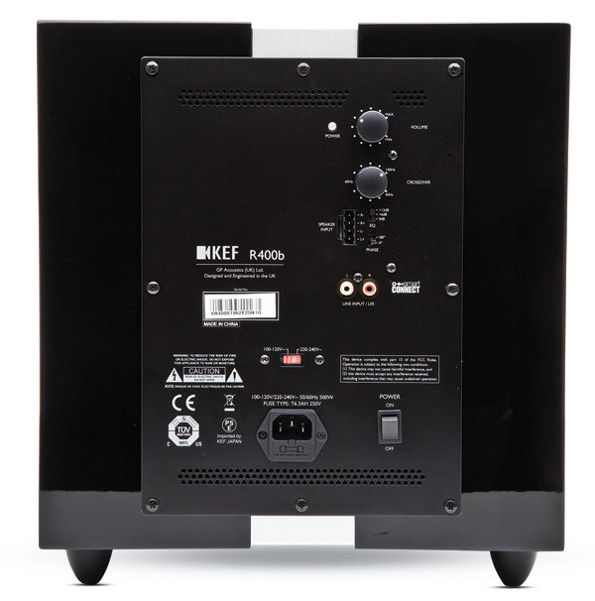KEF R900 Home Theater Speaker System Page 2
With two-channel music and the subwoofer off, the R900s produced a big, generous, spacious sound. While slightly forward sounding, they nevertheless produced an impressive sense of depth. The soundstage was solid, if just a bit less than absolutely pinpoint. I did briefly try the R100s up front, and they produced a little more soundstage precision than the big boys, as is often true of small monitor speakers. But even with the subwoofer engaged to fill out their bottom end, the smaller speakers could not match the solo R900’s full-bodied weight.
Bass response is the most difficult aspect of a speaker’s performance to convey in a review, since it can differ so radically between rooms. But the R900s, in my setup, dredged up everything I could throw at them from my favorite bass test tracks. They were tight and powerful when hammering out those big Kodo drums. On an early ’90s recording of Pictures at an Exhibition, transcribed for organ, they went impressively deep. If the latter sounded a little warmer in the midbass than might be ideal, the result was still plenty convincing for anyone who wasn’t there during the recording and knows how that organ actually sounded.

With synthesizer, which can produce perhaps the most challenging bass of all (though it can’t be compared to any real sound), the KEFs never gave up, never surrendered. They can’t rock a room in quite the same way as a big subwoofer, but for music, in my setup, I preferred the R900s full range, overall, to combining them with KEF’s R400b sub. I’d still opt for the subwoofer for video, and I did—see below. It’s better able to handle challenging material below 30 to 35 Hz.
There’s nothing that need be said about the midrange. Voices and solo instruments were clear and open, without bloat, boxiness, or any other identifiable coloration. At the top, the R900’s tweeter doesn’t jump out at you, but is simply there. Sibilants did sound a bit less prominent than I’m used to, but most listeners won’t object to that. Early on in the review, I thought I heard a little hardness in the low treble, but that appeared to work its way out as the listening hours accumulated.
My only reservation about the R900s (and the system in general) was a subtle lack of air at the very top end. Two steps helped overcome that, though not completely. First I increased the treble control on my Integra pre/pro to +1 dB. Controversial among audiophiles, yes, and it’s not an option on all AVRs and pre/pros. But you’ll get at least this much deviation at the listening seat in different, and differently furnished, rooms. Second, I tilted the R900s backward a bit by using a slightly longer spike in front. This put my ears closer to the tweeter axis; when straight up, the tweeter is 32 inches from the floor, 4 inches below my seated ear height.

The differences from both of these adjustments were subtle, but it’s the small things that drive audiophiles to drink. Cold sober, the R900s sounded terrific on music.
Movies
The KEFs were at their most impressive, however, with all 5.1 channels cooking. As is common in my room, the KEF center channel, positioned as needed on a low stand under the projection screen, added a bit too much warmth to male voices. I was able to improve this slightly by reducing the center channel bass control on my Integra pre/pro by a few decibels. Not all A/V receivers or pre/pros, including more recent Integra designs, offer this option. But even without it, dialogue intelligibility was good, with one exception: The heavy French accents in Ratatouille were sometimes a little hard to follow.
While dialogue intelligibility is important for first-rate home theater sound, the way a system handles soundtrack music is, for me, more significant. The KEFs beautifully captured the sweet-sounding strings, superb depth, and massive, epic scope of the best orchestral scores, from their subtlest moments to their loudest crescendos. If the system can be criticized at all, it’s perhaps for being just a little forgiving; the hard edges of brass and percussion lacked that last ounce of their signature edge and snarl.
From the smallest rush of wind to the most dynamic crash, the KEFs didn’t disappoint on sound effects, either. The fact that they rarely sounded grating or ear-threateningly edgy might be a negative to some, but a mercy to others. I wouldn’t have objected to just a little more bite to the sound when the action turned raucous, but as I’ve noted before, how many of us know what a 12-car pileup, an alien death ray, an exploding planet, or a massive firefight actually sounds like—or care to.
The dialogue on Patton was sublimely natural sounding on the KEFs. While the war sequences left little to the imagination (though thankfully largely missing the gore that peppers today’s war movies), the weighty battle sounds from this 1970 film won’t rattle your wisdom teeth—a limitation of the soundtrack, not the speakers. But the music, while missing the dynamic range of today’s best movie scores, sounded remarkably unprocessed on the KEFs, almost as if it came via direct feed from the scoring stage microphones to the film without the heavy processing used today—which it likely did.
But modern recording can add to a film in ways that were inconceivable 43 years ago. Patton is a great movie and doesn’t need 2013 technology to prove it. Prometheus, on the other hand, needs all the help it can get. The soundtrack certainly delivers, and the KEFs made the most of it. The aural candy begins with spectacular music cues over the opening credits, transitioning into the deep rumbling of a huge waterfall. Subtlety reigns in chapter three as the android David wanders the ship. The deep rumbling of the ship’s engines dominates the landing sequence in chapter seven. And the entire ending, beginning in chapter 32, is awash in music, effects, and a dynamic range that tests the system to the max. The KEFs never faltered under this immense torrent of sound.
If there’s a weak link in the KEFs’ chain, it’s the R400b subwoofer. For such a relatively tiny box, it handled the dynamics of Prometheus and other bass-heavy soundtracks such as Thor without a hiccup, but there are physical limits to how loud and how deep a small subwoofer can go. A larger subwoofer can navigate the bass acrobatics in modern soundtracks more convincingly in my room.
All of my comments here apply to my use of a single R400b. KEF kindly sent along two of them, but after considering the $1,700 (each) price, it appeared obvious that most buyers with a $3,400 budget for subwoofers are likely to opt for the greater capabilities available in one $3,400 sub than two at $1,700 each. Two subs can offer advantages, with careful placement, in overload margin and/or in-room bass uniformity. But they won’t go deeper than a single sub of the same design.
Conclusions
It’s getting more difficult today to audition speakers prior to purchase. That’s particularly true of a high-end package like these KEFs. But it will be well worth your while to hear this remarkable system. It’s hardly cheap, but in today’s high-end speaker market, you can spend a lot more for a lot less.
Editor's note: Regular readers may be aware that Home Theater audio editor Mark Fleischmann reviewed the KEF R Series last summer featuring the smaller R300 monitor speakers and the same R400b subwoofer. Mark received the sub with much greater enthusiasm, giving it higher ratings and designating it a Top Pick. These are differences in experience that can be readily attributed to several factors that may affect both the performance and perception of any subwoofer, including the overall size of the room that it's in (Mark's urban listening room in New York City is considerably smaller than Tom's private-home listening space in Los Angeles), the sub's placement in the room vis-à-vis the seating position and other furnishings, the speakers it's mated with (a subwoofer plays a more dominant role with smaller speakers), and the listener's personal taste: Tom is an acknowledged bass hound who's reference subwoofer is a 15-inch HSU Research VTF-15H, while Mark --perhaps due in part to his apartment setting--uses a 10-inch Paradigm Seismic 110 and, as is evidenced in his reviews, generally puts more emphasis on a subwoofer's musicality and mating with the main speakers than its ability to move a lot of air. Both reviewers’ comments and ratings are valid and should be read in this context, but the KEF 400b will retain its status as Home Theater Top Pick based on Mark's earlier review. You can find his review here.—Rob Sabin





























































